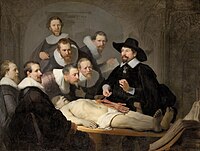
Photo from wikipedia
OBJECTIVE The last decennia autopsies have been declining worldwide, whereas non-invasive methods have been proposed as an alternative for the conventional autopsy. Some of these methods add needle biopsies to… Click to show full abstract
OBJECTIVE The last decennia autopsies have been declining worldwide, whereas non-invasive methods have been proposed as an alternative for the conventional autopsy. Some of these methods add needle biopsies to imaging techniques to provide an alternative to histological examination of autopsy-derived tissue. The aim of this study was to investigate the representativeness of the histology of computed tomography (CT) -guided post-mortem needle biopsies in comparison to autopsy derived tissue from the same organ. METHOD Consent of next of kin was obtained from relatives of deceased within the department of Internal Medicine to perform an autopsy, postmortem CT and CT-guided needle biopsies. The lungs and the liver were routinely sampled with CT-guided postmortem biopsies and during the autopsy. In some cases extra CT-guided biopsies of lesions reported on the CT were sampled. The biopsy and the autopsy reports were independently reported and retrospectively coded according to the Nationwide Network and Registry of Histo- and Cytopathology in the Netherlands (PALGA). Three pathologists with an interest in autopsy pathology and three physicians of the department of internal medicine separately and independently interpreted all histological results in relation to the cause of death as formulated in the autopsy report. Fleiss's Kappa was calculated and a consensus grade was defined. RESULTS Fleiss's Kappa showed substantial agreement in both lungs and moderate agreement in the liver. Of the 60 included cases 44% of the CT-guided postmortem biopsies in the left lung and 30% in the right lung showed false negative findings, primarily concerning a bronchopneumonia. In contrast, 91% of the liver biopsies showed concordant results, however only 22% of all liver biopsies concerned a major diagnosis related to the cause of death. The positive predictive value of the biopsies of the left lung, right lung and the liver were respectively 86.6%, 88.8% and 100%. The negative predictive values of these biopsies were 32.4%, 50% and 92.7%. CONCLUSION CT-guided postmortem biopsies of the lungs have a mediocre predictive value. Due to a low prevalence of relevant findings the overall usefulness of biopsies of the liver are limited. Conventional autopsy should still be preferred to biopsy-based postmortem examination. Postmortem biopsies are only an alternative if consent for an autopsy cannot be obtained. In the forensic setting, where no consent of the relatives is necessary, complete autopsy should always be the method of choice.
Journal Title: Forensic science international
Year Published: 2019
Link to full text (if available)
Share on Social Media: Sign Up to like & get
recommendations!